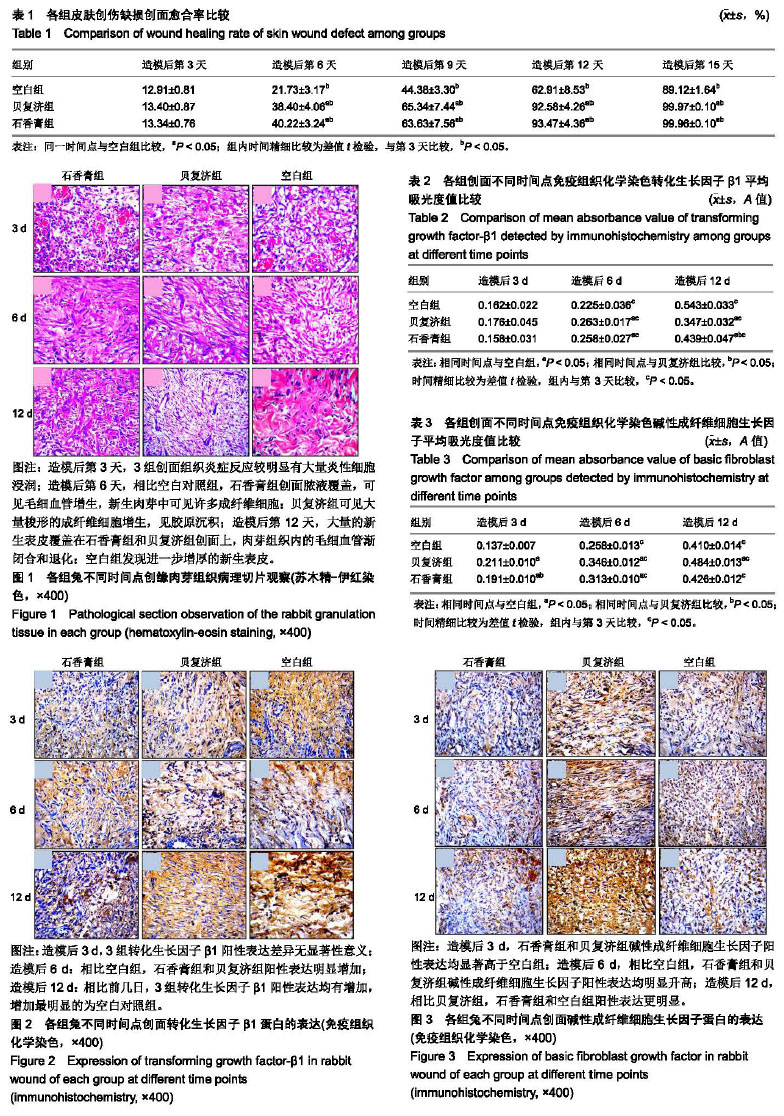中国组织工程研究 ›› 2019, Vol. 23 ›› Issue (27): 4350-4355.doi: 10.3969/j.issn.2095-4344.1384
• 组织构建实验造模 experimental modeling in tissue construction • 上一篇 下一篇
中药石香膏促进软组织缺损模型兔修复的机制
朱 旭,沈 骏,秧荣昆,王 勇,刘 洋,孙 权,贺祝英,陈久毅
- (贵阳中医学院,贵州省贵阳市 550001)
Mechanism of traditional Chinese medicine Shixiang plaster in promoting the repair of soft tissue defects
Zhu Xu, Shen Jun, Yang Rongkun, Wang Yong, Liu Yang, Sun Quan, He Zhuying, Chen Jiuyi
- (Guiyang University of Traditional Chinese Medicine, Guiyang 550001, Guizhou Province, China)
摘要:
文章快速阅读:
.jpg) 文题释义:
转化生长因子β(transforming growth factor β,TGF-β):是一个多功能的多肽家族,是组织受伤后细胞外基质积聚过程中的主导介质,它调节细胞的生长发育及组织受伤后的修复重塑。TGF-β1促进成纤维细胞、成骨细胞和许旺细胞的生长,对细胞的形态发生、增殖和分化过程起着重要作用,有利于胚胎发育和细胞修复。
成纤维细胞生长因子(fibroblast growth factor,FGF):是一同源性的多肽家族,由于其在体外能刺激成纤维细胞生长而得名,主要为a-FGF和b-FGF两大类,它们有极为相似的生物功能,如促进血管生成、诱导胚胎发育、促进神经生长等功能,是创伤愈合和上皮形成的重要调节物。
文题释义:
转化生长因子β(transforming growth factor β,TGF-β):是一个多功能的多肽家族,是组织受伤后细胞外基质积聚过程中的主导介质,它调节细胞的生长发育及组织受伤后的修复重塑。TGF-β1促进成纤维细胞、成骨细胞和许旺细胞的生长,对细胞的形态发生、增殖和分化过程起着重要作用,有利于胚胎发育和细胞修复。
成纤维细胞生长因子(fibroblast growth factor,FGF):是一同源性的多肽家族,由于其在体外能刺激成纤维细胞生长而得名,主要为a-FGF和b-FGF两大类,它们有极为相似的生物功能,如促进血管生成、诱导胚胎发育、促进神经生长等功能,是创伤愈合和上皮形成的重要调节物。
.jpg) 文题释义:
转化生长因子β(transforming growth factor β,TGF-β):是一个多功能的多肽家族,是组织受伤后细胞外基质积聚过程中的主导介质,它调节细胞的生长发育及组织受伤后的修复重塑。TGF-β1促进成纤维细胞、成骨细胞和许旺细胞的生长,对细胞的形态发生、增殖和分化过程起着重要作用,有利于胚胎发育和细胞修复。
成纤维细胞生长因子(fibroblast growth factor,FGF):是一同源性的多肽家族,由于其在体外能刺激成纤维细胞生长而得名,主要为a-FGF和b-FGF两大类,它们有极为相似的生物功能,如促进血管生成、诱导胚胎发育、促进神经生长等功能,是创伤愈合和上皮形成的重要调节物。
文题释义:
转化生长因子β(transforming growth factor β,TGF-β):是一个多功能的多肽家族,是组织受伤后细胞外基质积聚过程中的主导介质,它调节细胞的生长发育及组织受伤后的修复重塑。TGF-β1促进成纤维细胞、成骨细胞和许旺细胞的生长,对细胞的形态发生、增殖和分化过程起着重要作用,有利于胚胎发育和细胞修复。
成纤维细胞生长因子(fibroblast growth factor,FGF):是一同源性的多肽家族,由于其在体外能刺激成纤维细胞生长而得名,主要为a-FGF和b-FGF两大类,它们有极为相似的生物功能,如促进血管生成、诱导胚胎发育、促进神经生长等功能,是创伤愈合和上皮形成的重要调节物。摘要
背景:作者前期研究表明,在临床运用中药石香膏治疗大量的软组织缺损、慢性难愈合创面取得了患者认可的疗效。
目的:探讨中药石香膏促进软组织缺损修复的机制。
方法:成年雄性新西兰大白兔30只,由贵州医科大学实验动物中心提供,实验方案经贵阳中医学院动物实验伦理委员会批准。对30只大白兔采用经典的全层皮肤切割伤造模,随机分为石香膏组、阳性对照组(贝复济组)和空白对照组,分别在创面上外敷石香膏+用敷料覆盖、外喷重组牛碱性成纤维细胞生长因子+用敷料覆盖、不含药物的干净敷料覆盖创面。分别于造模后第3,6,9,12天进行换药,观察创面的愈合情况、肉芽组织情况,记录创面愈合时间;收集新生肉芽组织标本,病理切片观察成纤维细胞数量、血管改变情况;观察各组创面碱性成纤维细胞生长因子及转化生长因子β1蛋白表达。
结果与结论:①石香膏组与贝复济组创面愈合率高,愈合时间短,疗效优于空白组;②病理学观察石香膏组可见明显毛细血管增生,炎症反应轻,新生肉芽中可见许多成纤维细胞及炎性细胞浸润;在同一取材的条件下,造模后6,12 d,3组转化生长因子β1、碱性成纤维细胞生长因子蛋白表达均显著高于造模3 d (P < 0.05); ③结果表明,石香膏增加创面内源性生长因子转化生长因子β1和碱性成纤维细胞生长因子表达量,促进软组织缺损修复。
中图分类号:

.jpg)
.jpg) 文题释义:
转化生长因子β(transforming growth factor β,TGF-β):是一个多功能的多肽家族,是组织受伤后细胞外基质积聚过程中的主导介质,它调节细胞的生长发育及组织受伤后的修复重塑。TGF-β1促进成纤维细胞、成骨细胞和许旺细胞的生长,对细胞的形态发生、增殖和分化过程起着重要作用,有利于胚胎发育和细胞修复。
成纤维细胞生长因子(fibroblast growth factor,FGF):是一同源性的多肽家族,由于其在体外能刺激成纤维细胞生长而得名,主要为a-FGF和b-FGF两大类,它们有极为相似的生物功能,如促进血管生成、诱导胚胎发育、促进神经生长等功能,是创伤愈合和上皮形成的重要调节物。
文题释义:
转化生长因子β(transforming growth factor β,TGF-β):是一个多功能的多肽家族,是组织受伤后细胞外基质积聚过程中的主导介质,它调节细胞的生长发育及组织受伤后的修复重塑。TGF-β1促进成纤维细胞、成骨细胞和许旺细胞的生长,对细胞的形态发生、增殖和分化过程起着重要作用,有利于胚胎发育和细胞修复。
成纤维细胞生长因子(fibroblast growth factor,FGF):是一同源性的多肽家族,由于其在体外能刺激成纤维细胞生长而得名,主要为a-FGF和b-FGF两大类,它们有极为相似的生物功能,如促进血管生成、诱导胚胎发育、促进神经生长等功能,是创伤愈合和上皮形成的重要调节物。